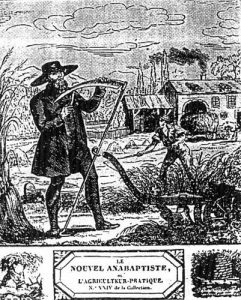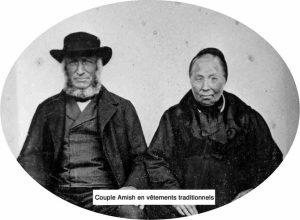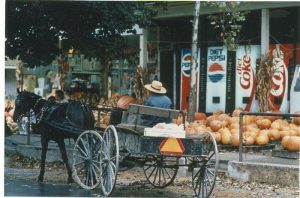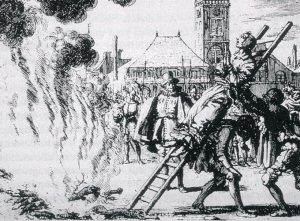The persecutions during the reign of Louis XIV
During the 17th century, numerous immigrants from Switzerland joined the Anabaptist communities scattered throughout Alsace since the 16th century. One of these newcomers was Jacob Amann, the founder of the Amish, a new dissident community. Thanks to their hard work and their farming abilities, the Amish community that settled in the valley of Sainte Marie aux Mines was highly successful. This aroused jealousy, and letters were written to the Court Chancellor, Voysin, warning him of the illegal settlement of Anabaptists in Alsace. The latter were not mentioned in the treaties of Münster and Osnabrück, signed in 1648, granting the Alsace Protestants a special status. Louis XIV decreed their expulsion from French territory. In September 1712, the Alsace Intendant ordered the bailiffs to have the expulsion of Anabaptists from French soil completed by the end of October. Because of such a hurried departure they were obliged to sell all their belongings at cut prices.
The Prince of Birkenfeld , successor of the Ribeaupierre dynasty, regretted seeing his farmers go and issued them with highly laudatory letters of introduction that enabled them to find new possibilities of settling outside France, in the Principality of Montbéliard (Montpelgard), Lorraine, the County of Salm, the Val de Villé, the Duché des Deux Ponts.
These circumstances increased the strength of the Amish community, whereas the economy of the valley of Saintes Marie aux Mines was considerably weakened. After the death of Louis XIV in 1715, a few families discretely returned to Sainte Marie aux Mines to become lease managers of the lands they had once owned.
A measure of toleration under Louis XV
Under the reign of Louis XV Anabaptists were tolerated, but with some restrictions such as the prohibition of wedding ceremonies. This measure, however, was never fully enforced since they were protected by the princes, the notables and even members of the clergy who employed them on their estates.
At this stage there were about twenty fellowships, meeting at the main farms of the Sundgau, at the tenanted farms of the Vosges valleys as well as numerous estates in the plains. In 1766, two brothers were bold enough to file a plea for exemption from taking the oath. The minister of Foreign affairs, the Duke de Choiseul, replied that they had better “let themselves be forgotten” and thus avoid the threat of expulsion. Such situations encouraged the Anabaptists to close themselves off from the rest of the world and live in secluded places.
Outstanding farmers
This is how Counsellor Kroeber, the administrator of the mines in Saintes Marie aux Mines who hoped for their return, described them to the administrative officer : “the Anabaptists are by nature very hard-working people who make considerable efforts to clear uncultivated land. They are especially efficient – and more so than the other inhabitants of Alsace – in the art of breeding cattle, as well as in cattle care and trade…”
We owe them significant innovations in cattle breeding and other agricultural techniques. Some examples are the crossing of cattle from the Canton of Berne with local livestock to obtain the Montbéliarde breed, the technique of irrigation, the making of artificial meadows, and the practice of crop rotation which avoids the necessity of leaving fields lie fallow.
The Revolution
As from the French Revolution, the Anabaptists became French citizens and could at last enjoy a legal existence and once more become landowners.
But several problems arose during the revolution : the taking of the oath of loyalty to the constitution of the republic and – more especially – the problem of military service.
Anabaptists were opposed to taking any sort of oath, but they succeeded in having a commitment accepted as being equivalent to an oath. As staunch pacifists, they obtained an exemption from service with the militia.
They refused compulsory army conscription and were treated as cowards and traitors to their country. But when Goupilleau – a conventionnel from Paris – visited an Anabaptist from Salm named Jakob Kupfershmitt, he said of them : “I believe they are the best men on earth.”
This encouraged the Anabaptists to send a delegation to Paris in 1793. They returned with a recommendation from the Comité de Salut Public that decreed their exemption from military service.
How they obtained this recommendation remains a mystery. They are the only community for which such a demand was taken into account at a time when “the country was in grave danger”.
Recommendation passed by the Comité de Salut Public: “The French citizens, the Anabaptists of France, have sent some of their representatives to submit to us that their religion and their morals forbid them to carry arms and to seek leave from us to be employed in the army in any other form. Taking into account their meekness of heart and believing that a sound government must ensure that all virtues work for the common good, we advise you to treat the Anabaptists with the meekness that is theirs, to spare them all kinds of persecutions, to grant them to carry out the army service they request – such as scouts or drovers – or even allow them to discharge themselves of the said services in exchange of a sum of money. Signed by Couthon, Barrière, Hérault, Saint-Just, Thuriot, Robespierre.”
Departure for the USA
Later, under Napoleon, the use of arms once more became obligatory for them. This triggered off the departure of a great number of Amish from Alsace and Lorraine to the New World.
The Amish community, with its specific clothing and customs, is still flourishing in the USA today.







